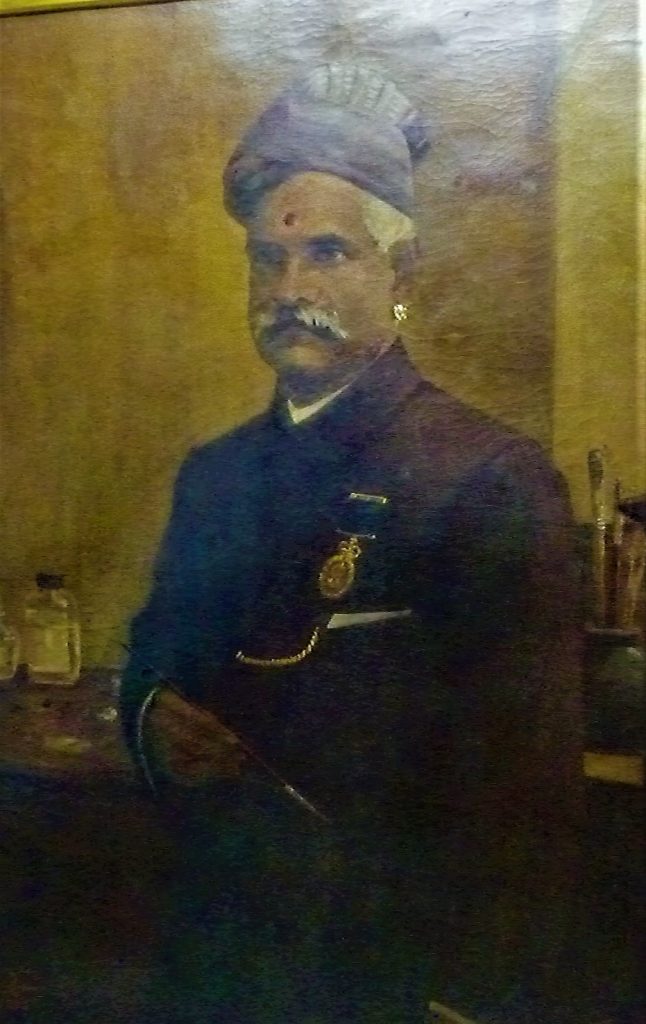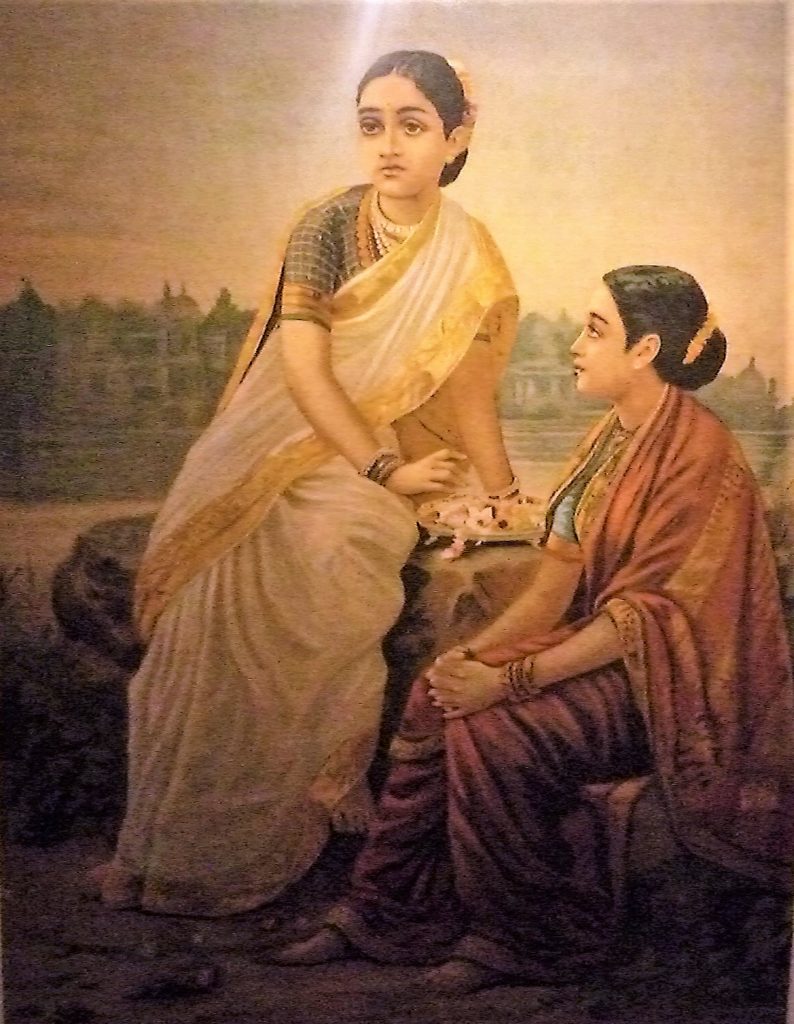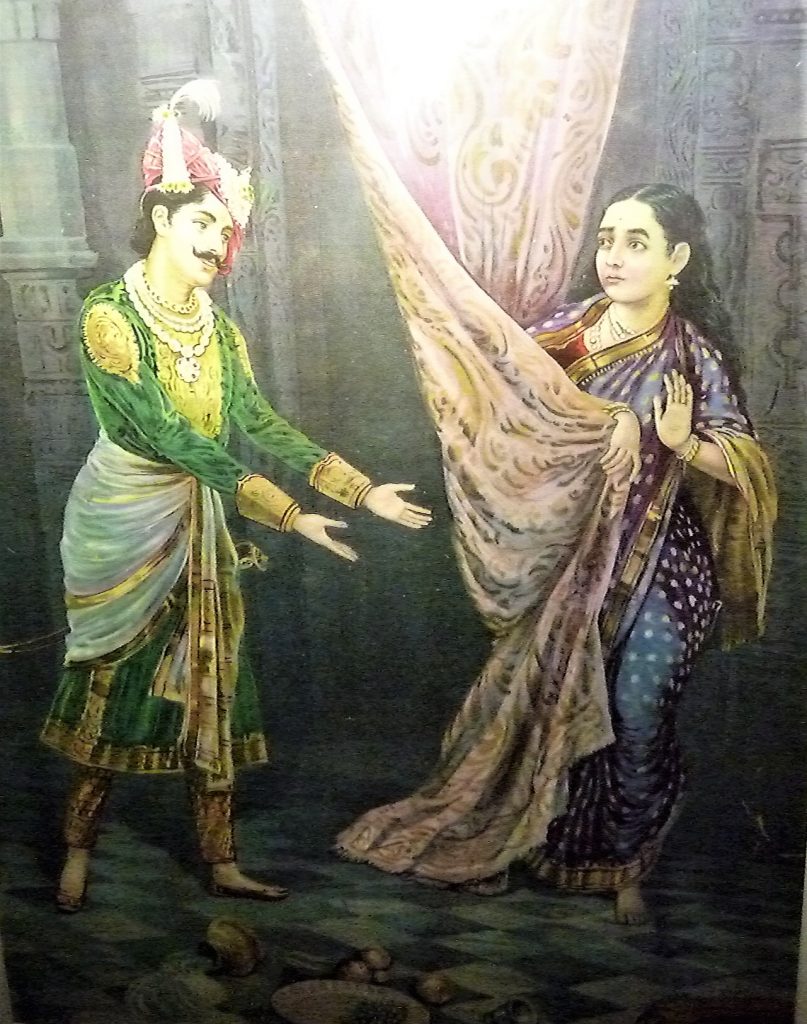Raja Ravi Varma was born in 1848 in Kilimanur, which was inhabited by about 200 people of the Kilimanur clan, and he later died in 1906. He was born as a Ksatriya; a part of the warrior class in the Indian caste system (Rupika 20). This caste distinction allowed him to successfully pursue a career in art because of the privilege and connections this caste holds. Ravi’s father was known as a namboothiri brahmin the highest among all brahmins in his area, while his mother was an acknowledged poet (Rupika 25). But even with these great influences and broad skillsets exposed to him, his uncle Raja Raja Varma was the one who inspired and taught him to paint. The prefix “Raja” before Ravi Varma’s name symbolizes the recognition and credit he received as a painter (Rupika 19). After years of practice and broadening his knowledge and skills, Ravi Varma submitted his first two paintings to the Fine Arts exhibition in Madras, and to people’s surprise, he was awarded a gold medal by the governor (Rupika 22). After this initial recognition he believed himself ready to begin his travels and expand his career. His travels began in Travancore, there, with his background from Kilimanur, his status, and his proximity to the royal family aided in his growth as an artist, gaining him many new opportunities (Rupika 36). Because of Varma’s orthodox background, knowledge of scriptures and classical literature, and his incredible innate ability to paint, he was able to expand his sensibilities among the court in Travancore (Rupika 37). This in turn allowed him to make important connections with the influential members of the court which led to him acquiring more opportunities for painting commissions. Varma was first known for his massive oil paintings; the style and use of oil painting was introduced by the Europeans (Rupika 38). The style and scale of his paintings allowed a broader audience to enjoy one, or many pieces of art at once rather than a smaller audience only being able to admire at close range. As oil paintings could be made on massive canvases, the idea that a painting could be moved around, hung on a wall and observed at convenience was very appealing to Varma, as his dream was to have a huge exhibition of oil paintings created by him, displayed in a gallery (Rupika 157).

Varma became well aware of the many styles that were being introduced by the Europeans (such as oil paintings on canvas, academic realism, and chiaroscuro) but was also aware of the many traditional and historical styles that had been part of Indian culture, his very own upbringing, and traditional art for a very long time (such as the Chitrasutra, from the Vishudharmottara) (Rupika 157). With all this knowledge, one of the main modern techniques he chose to incorporate was lithography. Lithography was created just before 1800 by Aloys Senefelder and it became one of the most popular mediums of the 19th century (Davies 911). Lithography involves the practice of drawing a design onto stone with a specific grease crayon, then dampening the stone with water which absorbs into the stone but does not absorb where the design is. The artist then applies ink to the stone which adheres to the crayon design, the stone is then put through a press where the design is transferred onto paper. This allows for many copies of one design to be made and saves artists tons of time (Davies 911). Through this process he was able to create amazing calendar art, known as oleography; prints made and texturized to resemble oil paintings. This allowed Varma’s art to become even more accessible to the masses and made his beautiful work more affordable and more popular. These prints often depicted Hindu deities and allowed anyone, no matter their class distinction to have a beautiful print with the deities they worshipped, and stories and tales that were known to them. No one had attempted his particular combination of styles before, Ravi utilized the richness of ancient stories and techniques but also incorporated modern varieties which created something purely unique. He was conscious of his selection of themes, genres, and the mediums in which he desired to paint and print. His representation of historical gods and heroes, the portraits of the rich and powerful as well as the many women he portrayed allowed him to prevail and put western influences to good use when it best suited him (Rupika 158). But, his stylistic choices received heavy criticism from traditional Indian artists, as well as European artists that believed his art was too vulgar, or too subtle, and did not follow the traditional ways of each group (Pande 130). Ravi Varma’s style was something never seen before which gave him an edge over other artists of his time.

In Varma’s portraits of females, the dresses, and jewellery portrayed were used to signify class and ethnic identity. Varma’s ability to capture the realness, vividness, and glow of the jewels these women wore was unsurpassable. Varma’s color palette and skill was said to become the inspiration for many deities now portrayed in temples after his time (Pande 130). His paintings as well as prints also brought forward the beauty and pride that Indian culture held which other colonizers and cultures were not aware of. His sophisticated paintings showed the beauty and dignity of the women, and also the status and power of men. From the colonizer’s point of view, India was a dull landscape of heat and dust, filled with beggars and fakirs, but Varma’s paintings showed the dazzling people of India that no foreigner could discredit (Pande 131). His work aided in the growth and achievement of independence for India by showing the pride and joy Indian people felt and by giving them proper representation and access. He is said to have brought a new visual style and vocabulary to the Indian world of art.
In many of Varma’s paintings he makes the effort to bring light into the private life of men and women in their personal interior spaces. He used a technique called Chiaroscuro, a modern technique, to make interior spaces more compelling and more dramatic to the viewer. This was originally a western practice that Varma took on and used to his advantage in his series of men reading books (Dinkar 2). His beautiful paintings were included in the budget to decorate the homes of the royal families of Mysore and Baroda, his mythological paintings were also frequently seen in these homes. His style and broad skillset is said to bridge the gap between the ancient stories and talents of India with the new, contemporary, and western styles used today (Dinkar 6). His venture into painting deities and mythological beings that were so well known by all of the Indian population, along with his unique style and abilities allowed him to have a career of fame and success. He would become most remembered and known for his mythological paintings and prints (Thakurta 181). One of the many known paintings of Varma’s is called the ‘Hamsa Damayanti’, this images connotes the idea of beauty and womanhood in Indian life, but pictured with this beautiful woman is a swan, which carries the meaning beyond a regular woman and into the mythic character of Damayanti, who is part of an epic legend known in India. This painting is known for conveying the ideas of transformation and transmutation of values (Thakurta 182). His many images and paintings of women became popular and well known because of the myth, aura, and beauty of these figures which gave them the privileged title of ‘real life celestial beauties’ (Rupika 140). These painting were some of the first to draw awards and mounting publicity for Varma (Thakurta 180).

One deity of interest to Varma was Mohini, the female form of Visnu. She is the subject of several mythological tales, and her image was used in many paintings done by Varma. He portrayed the goddess as living the normal life of an Indian woman; many of the positions she is seen in connects to forms and sequences of traditional dances, which carry immense meaning in Indian culture. She is also pictured playing instruments such as the violin, as well as playing with a ball as a symbol of togetherness (Rupika 212). Instruments and music had special meaning to Varma as they were key factors and a common activity found in his childhood home (Rupika 211). The intention behind these paintings was to give insight into the private lives of young women who were awaiting and anticipating their future life with their chosen groom. Because of this, these paintings were often aimed to appeal to male audiences because of their curiosity and fascination with women (Rupika 212). This gives more meaning to the painting as they hold traditional Indian styles and values, modern techniques, and personal connections. Varma painted with compassion, purpose, and skill, thus allowing him to convey true emotion, status, and mythologies, which gave deep worth to each painting. These aspects carried over into every one of his prints, all showing his incomparable style and displaying cherished stories held within. These amazing abilities gave him the well-earned title as an original, talented, and respected Indian artist, unforgettably known as Raja Ravi Varma.
Bibliography and Recommended Readings
Davies, Penelope (2010). “Post-Impressionism.” Janson’s History of Art. Upper Saddle River: Pearson, 911-918.
Dinkar, Niharika (2014) “Private Lives and Interior Spaces: Raja Ravi Varma’s Scholar Paintings.” Wiley Online Library Vol. 37, Issue 3. Accessed January 30, 2020. doi-org.ezproxy.uleth.ca/10.1111/1467-8365.12085
Pande, Ira (2010) “Review: A King Among Painters” India International Centre Quarterly Vol. 37, No. 1, 128-133. Accessed January 30, 2020. www.jstor.org/stable/23006462.
Rupika, Chawla (2010) Raja Ravi Varma: Painter of Colonial India. Ahmedabad, India: Mapin Publishing.
Thakurta, Tapati Guha (1986) “Westernisation and Tradition in South Indian Painting in the Nineteenth Century: The Case of Raja Ravi Varma.” Sage Publications 165-195. Accessed January 30, 2020.
Related Topics
Puranic paintings
Raja Raja Varma
Painting style in Tanjore
Academic Realism
Oil painting
Lithography
Portraiture
Epic tales
Hindu goddesses
Chitrasutra, from the Vishudharmottara
Fine Arts exhibitions in India
Hindu deities in art
Oleography
Mythological stories
Western influence on India
Related Websites
https://en.wikipedia.org/wiki/Raja_Ravi_Varma
https://fineartamerica.com/art/paintings/raja+ravi+varma
https://www.mojarto.com/blogs/from-raja-ravi-varma-to-the-masses-calendar-art-in-india
https://en.wikipedia.org/wiki/Hindu_deities
https://www.centrecolours.co.uk/a-printing-revolution-the-history-of-lithography
http://www.keralaculture.org/rajaravivarma/97
Article written by Camryn Smith (March 2020) who is exclusively responsible for its content.
